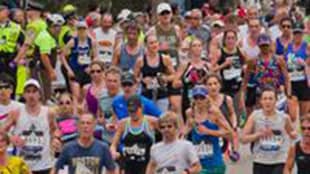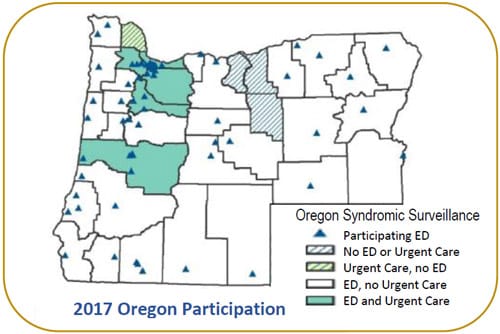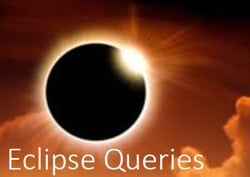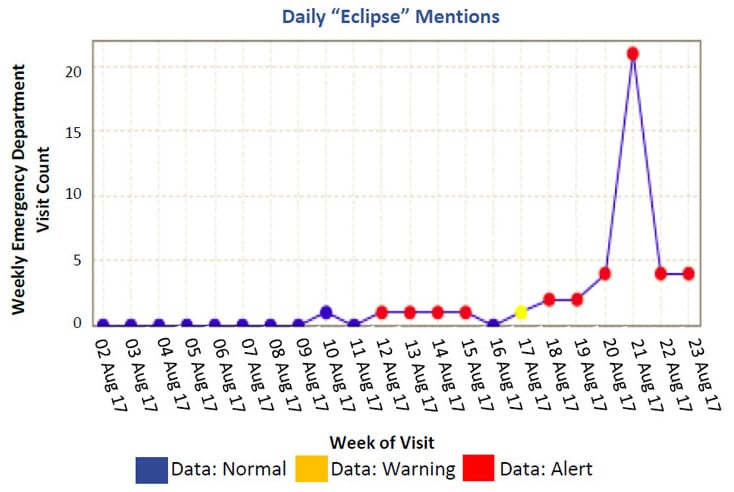How Oregon Tested its Mass Gathering Protocol and Mobilized Communities
Mass Gatherings

Mass gatherings such as festivals and sporting events pose unique challenges to public health. There is a risk of injury from activities and not only do people in large crowds spread disease through close contact, they can transport the disease when they leave. Increased medical needs can overwhelm local healthcare resources. Well-coordinated planning and the use of syndromic surveillance can help public health officials detect risks posed by these events early and respond in a timely manner to prevent health threats.
In August 2017, people gathered coast to coast to watch the total solar eclipse. Knowing Oregon would offer particularly good views of the eclipse, health officials prepared for problems associated with mass gatherings. They developed a syndromic surveillance eclipse-specific mass gathering guide for local public health departments to monitor data for visits related to the influx of visitors expected to attend the “Great American Solar Eclipse Event.” This was a cost- and resource-effective way to provide statewide surveillance while mobilizing local health departments to take part in the larger public health effort.
Having the ability to do monitoring of this type improves situational awareness for mass gatherings. Funding from the National Syndromic Surveillance Program supports the use of syndromic surveillance in improving the nation’s public health.
Public Health Problem
Mass gatherings1 (e.g., concerts, festivals, sporting events, political rallies, and religious gatherings) pose unique challenges to public health officials. Risks associated with large events can vary and are influenced by factors such as crowd size and age (range, or average/mean), weather, event type and purpose, and use of alcohol or drugs. Often, the risk of injury increases. And not only do people in large crowds spread disease through close contact during an event, they can transport the disease when they leave. Healthcare resources can therefore be overwhelmed. Well-coordinated planning will help public health officials detect risks posed by this kind of event early and respond in a timely manner to prevent health threats.
On August 21, 2017, people gathered coast to coast to watch the total solar eclipse. Knowing Oregon would offer particularly good views of the eclipse, health officials prepared for problems associated with mass gatherings before, during, and after the event:
- A potentially overwhelming number of visitors were anticipated in counties in the path of totality.
- Many of these counties are rural, with transportation and healthcare infrastructure built to accommodate only the resident population.
- Counties outside the path of totality also anticipated many travelers driving through the path of totality or choosing to view locally.
Actions Taken

Health officials in Oregon developed an eclipse-specific mass gathering guide2 for local public health departments to collect data for visits related to the influx of visitors expected to attend the “Great American Solar Eclipse Event.” The guide listed 11 priority queries, grouped into four categories: health system capacity (total visits, percent visits by age group, medication refills), outdoor exposure (asthma-like, heat related, mammal bites, snake bites), injury or substance abuse (alcohol use, motor vehicle-related), and communicable disease (fever, nausea/vomiting/diarrhea). Priority queries were either known seasonal hazards or had potential to overwhelm healthcare services.

Eye Injury (Chief Complaint/Discharge Diagnosis)
(, ^;H53^ ,or, ^;368^ ,or,^;H31023^ ,or, ^;E11219^ ,or,^;36210^ ,) ,and, (, ^blind^ ,or,^blur^ ,or, ^vision^ ,or, ^ retinopath^ ,or, ^conjunctivitis^,or, (, ^eye^ ,and, (, ^pain^ ,or,^problem^ ,or, ^irritation^ ,or,^injury^ , ) ,) ,) ,andnot, (,^foreignbody^ , ^abdominal^ ,^fall^ , ^cut^ , ^assault^ ,)
Eclipse (triage note)
^eclipse ^ ,andnot, ^mitsub[ui]shi^
The guide also listed eclipse-specific queries such as number of visits where “eclipse” was noted in triage notes. All queries were intended to gather data to improve situational awareness, develop messages, and plan interventions. The guide provided reminders on ESSENCE functionality (e.g., develop queries, set up and share dashboards, graph results), screen shots, and guidance on interpreting data. This guide provided comprehensive information for local health departments to be able to use syndromic surveillance for the eclipse. While state-level surveillance efforts were more comprehensive, and included active surveillance and data streams not available to county users, these queries (see sidebar), formed the core of efforts at the Oregon Public Health Division. This was a cost- and resource-effective way to provide statewide surveillance while mobilizing local health departments to take part in the larger public health effort.
To monitor key health indicators from patient visits to emergency departments (EDs) and urgent care centers, the Oregon Health Authority uses the Electronic Surveillance System for the Early Notification of Community-based Epidemics, known as ESSENCE. All 60 eligible hospitals send ED data every day for syndromic surveillance. Data are then submitted to the National Syndromic Surveillance Program.
Outcome
Total statewide visits to EDs and urgent care centers did not rise above expected levels during the eclipse surveillance period, though regional visits did spike in some areas with large numbers of expected visitors. Visits by out-of-state residents also increased significantly. Visits for motor vehicle-related accidents increased slightly because of a spike in visits by out-of-state residents.
Mentions of the solar eclipse in ED and urgent care records peaked the day of the eclipse (21 visits) and then decreased. Providers noted the eclipse in visit triage notes for various reasons—due to falls or other trauma incurred while traveling to or leaving an eclipse viewing location or substance abuse or behavioral health issues or ocular issues from looking at the eclipse. Regardless of findings, having the ability to do monitoring of this type improves situational awareness.

Mentions of the solar eclipse in ED and urgent care records peaked the day of the eclipse (21 visits) and then decreased. Patients reported the eclipse for various reasons.
Lessons Learned
- For planned events, develop guidance for using syndromic surveillance ahead of time. Clarify how data can be used and shared. Pilot this guidance with local health department partners, and use their feedback to improve the process.
- Develop report templates. Let internal and external partners know what syndromic data will be shared and when these data can be used for decision making in other parts of the response.
1 OHA Regulations, 333-039-0005. For the purpose of permitting, an outdoor mass gathering is defined as an “actual or reasonably anticipated assembly of more than 3,000 persons.”
2 Oregon Health Authority. Oregon Essence: Using ESSENCE for Mass Gathering Surveillance [online]. 2017. [cited 2017 Sep 18]. Available from URL: http://www.oregon.gov/oha/PH/DISEASESCONDITIONS/COMMUNICABLEDISEASE/PREPAREDNESSSURVEILLANCEEPIDEMIOLOGY/ESSENCE/Documents/using-essence-mass-gathering.pdf
Contacts
Acute and Communicable Disease Prevention Program
Oregon.ESSENCE@state.or.us
Office of Public Health Data, Surveillance, and Technology
Division of Health Informatics and Surveillance
www.cdc.gov/nssp
This success story shows how NSSP
- Improves Data Representativeness
- Improves Data Quality, Timeliness, and Use
- Strengthens Syndromic Surveillance Practice
- Informs Public Health Action or Response
The findings and outcomes described in this syndromic success story are those of the authors and do not necessarily represent the official position of the National Syndromic Surveillance Program or the Centers for Disease Control and Prevention.
